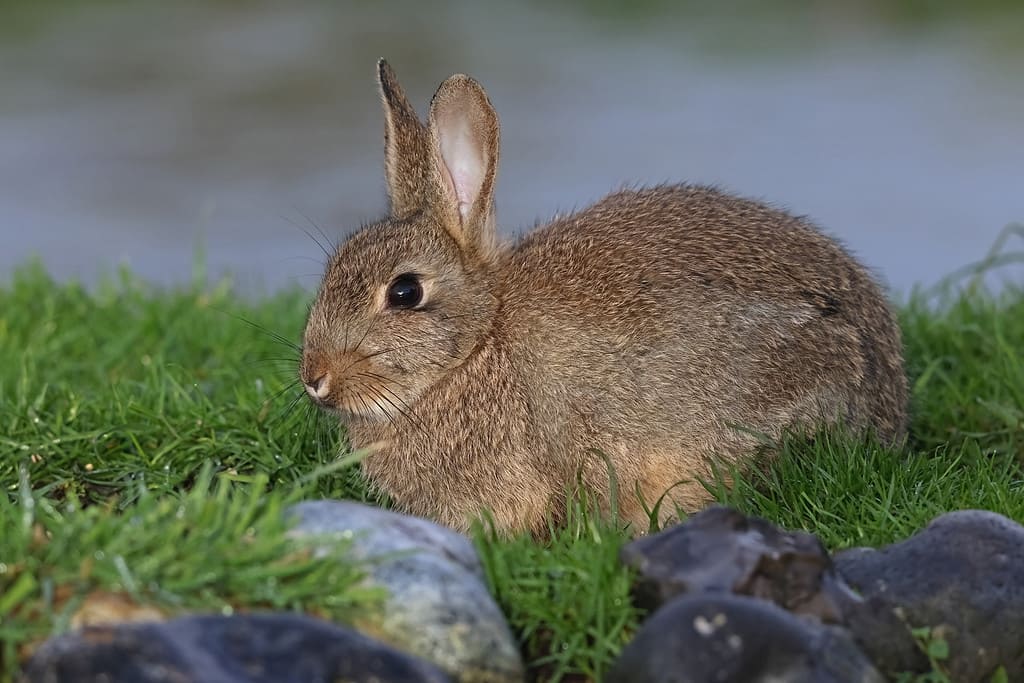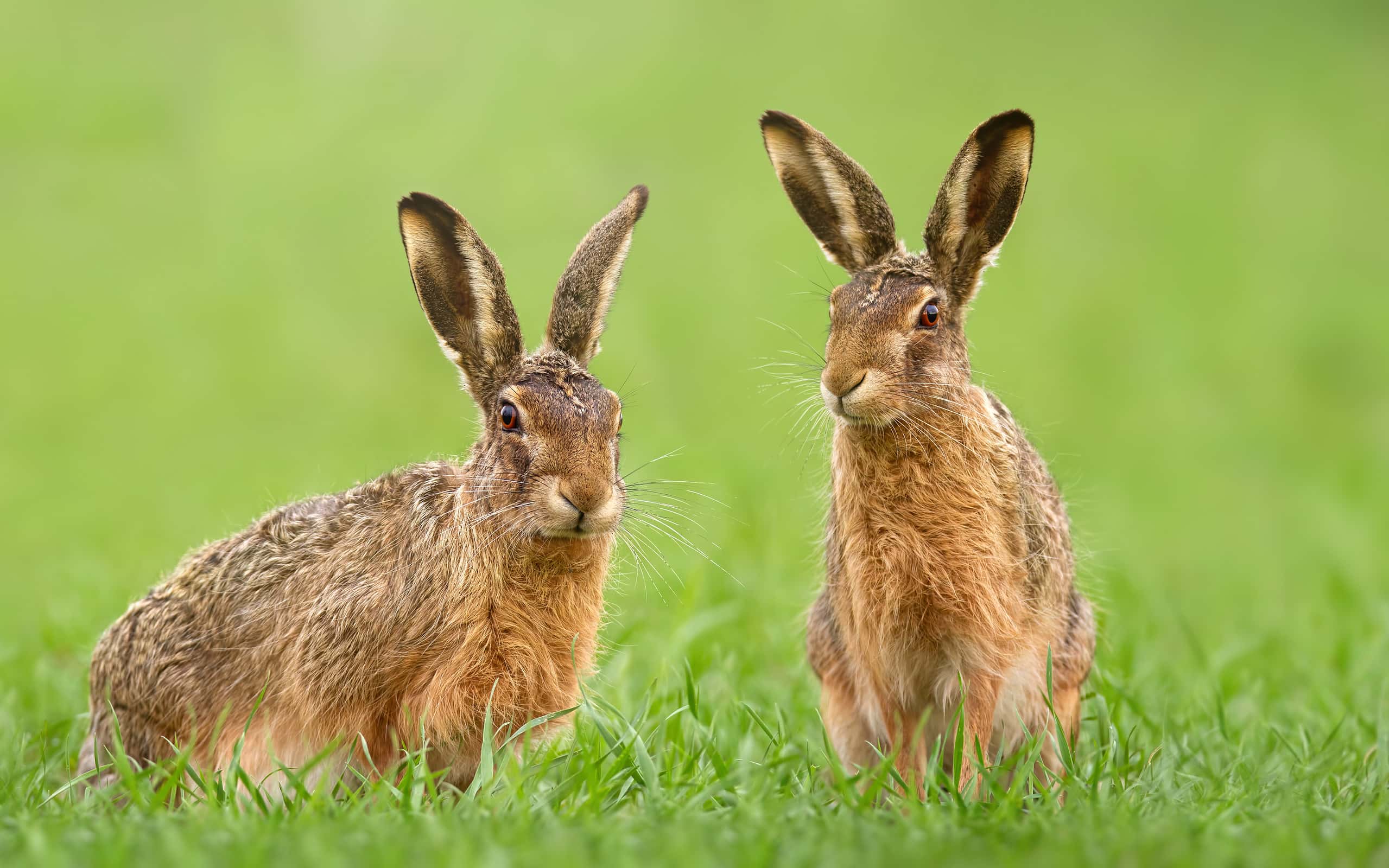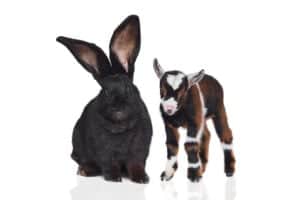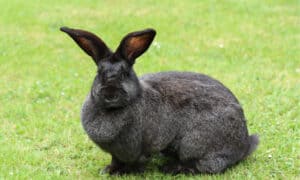While you can spot rabbits and hares (family Leporidae) across England today, did you know they are actually not native to the area? In fact, only one species is native to the entire island of Great Britain, and until its introduction further south, it was only found in Scotland. Two other species native to continental Europe are now also found in England, both believed to have been introduced by the ancient Romans some 2000 years ago. Read on to find out what rabbits and hares now call England home, and how they rank in size.
#1 European Hare (Lepus europaeus)
Size: 60 – 75 cm
Weight: 3 – 5 kg

The European hare has longer ears than its cousin the mountain hare as well as distinct amber eyes.
©WildlifeWorld/Shutterstock.com
The European hare, also known as the brown hare, is originally native to continental Europe and Asia. However, humans then introduced it elsewhere as a game animal, including in parts of North and South America, Australia, and New Zealand. The ancient Romans may have also first introduced it to Great Britain. It is the largest of the three species now found in England and one of the largest of all hares. European hares are found in woodland, grassland, and farmland habitats, and are most commonly encountered in eastern England.
#2 Mountain Hare (Lepus timidus)
Size: 43 – 61 cm
Weight: 2 – 4 kg (females usually slightly heavier than males)

This mountain hare is molting out of its snowy white winter coat and back into a brown coat for spring.
©MikeLane45/iStock via Getty Images
The mountain hare is the only species on this list native to Great Britain, with a natural range that extends into Scotland. They now also exist as an introduced species in the Peak District of England. It is another large hare, but slightly smaller than its cousin the European hare. As a species primarily of polar and montane habitats across Eurasia, its coat has adapted to molt with the seasons, turning white for the winter and then back to brown in the spring. In England, they are mainly found in upland and moorland habitats.
#3 European rabbit (Oryctolagus cuniculus)
Size: 38 – 50 cm
Weight: 1.5 – 2.5 kg (males usually heavier than females)

This European rabbit in Norfolk, England may have the ancient Romans to thank for bringing its ancestors over from continental Europe.
©neil bowman/iStock via Getty Images
The European rabbit, also known as the coney, is originally native to Southwestern Europe as well as a portion of the Atlas Mountains in northwestern Africa. The ancient Romans may have then spread them across much of the rest of Europe, including the British Isles. It is both the most common and the smallest of the three lagomorphs found in England, and the only rabbit. You can thus also easily distinguish them from the other two by their relatively smaller ears and shorter limbs. They are widespread across England in a variety of habitats and can even be found in urban areas.
Conclusion
There are only three species of rabbits and hares currently found hopping around England. Furthermore, none of these are even originally native to the region but rather are introduced species. The largest of these is the European hare, which is also one of the largest of all the lagomorphs. Then there is the slightly smaller mountain hare, found only in the Peak District. Finally, there is the smallest of the three and the only rabbit, the European rabbit. While the mountain hare has a native range to the north in Scotland, the other two are theorized to have been brought over from mainland Europe by the ancient Romans.
It is also important to remember that all breeds of domestic rabbit (Oryctolagus cuniculus domesticus) derive from the wild European rabbit. There are now over 300 breeds of domestic rabbits, and they come in a wide variety of sizes and colors. It is always possible that you may see a lost or abandoned individual out in the wild. If you believe you have found a non-wild rabbit, please contact a local rabbit rescue for help!
Summary of the 3 Largest Rabbits and Hares Hopping Around England
| Common Name | Scientific Name | Size | Weight |
|---|---|---|---|
| European Hare | Lepus europaeus | 60 – 75 cm | 3 – 5 kg |
| Mountain Hare | Lepus timidus | 43 – 61 cm | 2 – 4 kg (females usually slightly heavier than males) |
| European rabbit | Oryctolagus cuniculus | 38 – 50 cm | 1.5 – 2.5 kg (males usually heavier than females) |
Thank you for reading! Have some feedback for us? Contact the AZ Animals editorial team.








